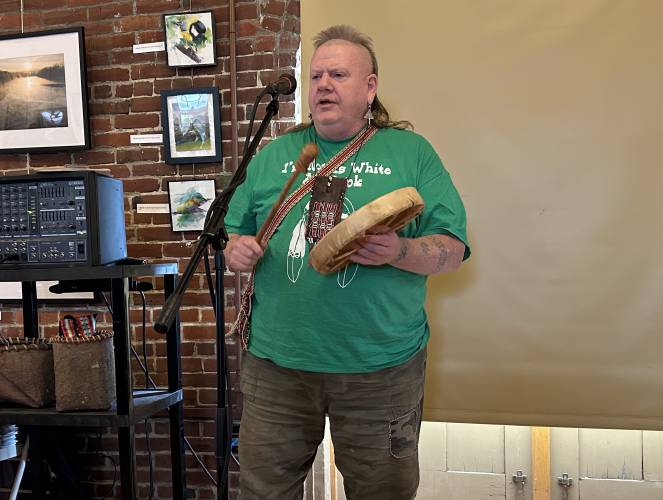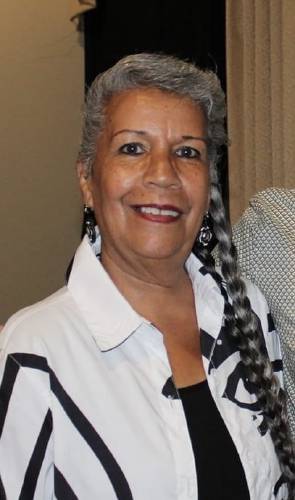Saturday event to remember Great Falls Massacre, 349 years later
| Published: 05-15-2025 12:00 PM |
TURNERS FALLS — To commemorate the 349th anniversary of the Great Falls Massacre and the 21st anniversary of the 2004 reconciliation ceremony, the annual Day of Remembrance gathering will be held on the lawn behind the Great Falls Discovery Center on Saturday, May 17.
The free event is organized by the Nolumbeka Project, a local nonprofit Indigenous history and culture preservation organization, to recognize the May 19, 1676 Great Falls Massacre where more than 300 non-combatant Native Americans, mainly women and children, were killed by English forces led by Capt. William Turner during a surprise attack. The 2004 reconciliation ceremony marked the town of Montague and members of the Narragansett tribe formally recognizing the 1676 conflict.
This year’s Day of Remembrance will feature presentations and speeches by Liz Coldwind Santana-Kiser, tribal historic preservation officer for the Chaubunagungamaug band of the Nipmuck people; Jose Ite “Little Arrow” Santana, treasurer of the Chaubunagungamaug Nipmuck Indian Council and founder of the Nipmuc Cultural Hunt and Fish Club; and Roger Longtoe Sheehan, chief of the Elnu Band of Abenaki.
To begin the gathering, which starts at 1 p.m., there will be a ceremonial fire with tobacco for offerings, according to Nolumbeka Project President David Brule. He will act as the emcee, and he plans to say a few words on the history of the massacre while taking cues from the speakers and what information they provide in their presentations. He expects to discuss the progress made on the archeology project overseen by Montague’s Battlefield Grant Advisory Committee to better understand the events of the Great Falls Massacre.
Brule said for many Indigenous people, the trauma associated with the massacre led the events to be largely forgotten and not discussed.
“So many people have turned out and have heard this story, which we were not able to know a generation ago. It just wasn’t there for us to find out about, and it was buried,” Brule said, explaining how even some of the Indigenous members of the Battlefield Grant Advisory Committee were unaware of parts of the history of the massacre.
In his perspective, Brule said the Day of Remembrance has offered a formalized opportunity for Native and non-Native people to remember and learn about what happened in 1676, and has grown in size since it started.
While Indigenous people have remembered and honored the day in their own way for many years, Brule said this is a public opportunity to honor those lost during the massacre with tribal representatives present.
Article continues after...
Yesterday's Most Read Articles
 ‘A whole lot of fun’ on the water: Christmas in July boat parade returns Saturday
‘A whole lot of fun’ on the water: Christmas in July boat parade returns Saturday
 New role focused on downtown development in Northfield, Turners Falls and Shelburne Falls
New role focused on downtown development in Northfield, Turners Falls and Shelburne Falls
 Several area departments put out Northfield house fire
Several area departments put out Northfield house fire
 Erving man, 60, found dead in Montague Plains Wildlife Management Area identified
Erving man, 60, found dead in Montague Plains Wildlife Management Area identified
 Firefighters partner with Jumptown to practice water rescues in Orange
Firefighters partner with Jumptown to practice water rescues in Orange
 Trio unopposed for Greenfield City Council seats
Trio unopposed for Greenfield City Council seats
“This has been the point where we have deliberately made sure that local representatives of the tribes that lived here for 10,000 years, that they have a presence and they are acknowledged, so that’s a really important point,” he said.
Brule added that this is also an opportunity to make space for healing rather than sadness, and when non-Native people express guilt over what occurred, to remember that expressing curiosity and learning is contributing to healing after many centuries.
“What I try to get across to people is yes, this is a terrible thing that happened, and yes, we are working on healing,” Brule said. “It’s not an explicit process of healing, but it is more … implicit just by being there, and by acknowledging and expressing concern, and interest and finding out what really happened.”
In the event of rain, the Day of Remembrance will be held inside the Great Hall of the Great Falls Discovery Center at 2 Avenue A. Light refreshments will be served.
Erin-Leigh Hoffman can be reached at ehoffman@recorder.com or 413-930-4231.








 Gov. Healey forms Anti-Hunger Task Force in response to federal SNAP cuts
Gov. Healey forms Anti-Hunger Task Force in response to federal SNAP cuts South County reporter bids adieu after four years
South County reporter bids adieu after four years
